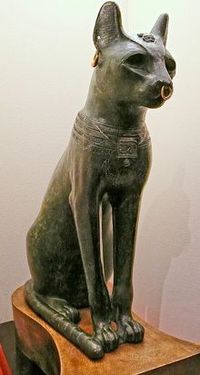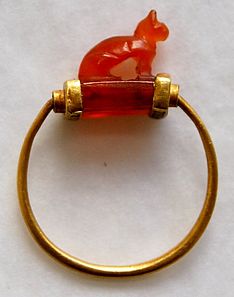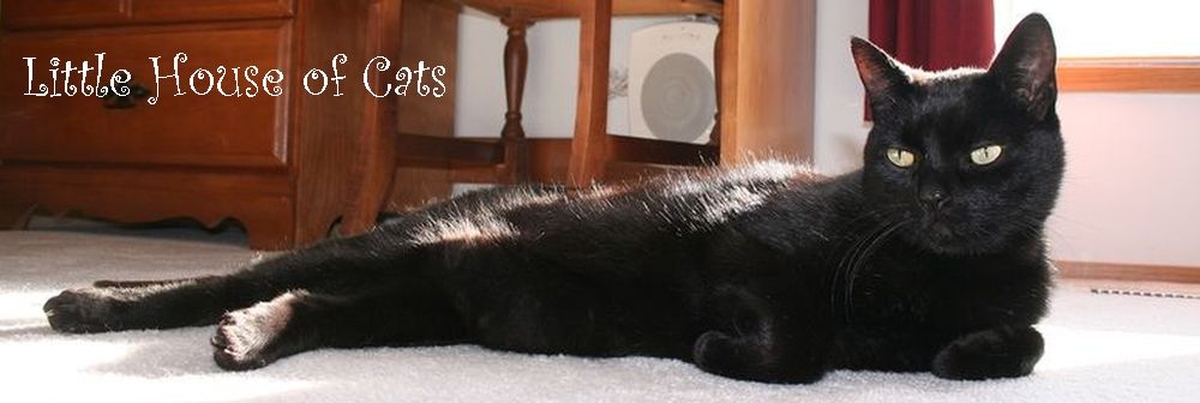The British Museum first opened to the public in 1759, and amongst its enormous collection of seven million objects are those relating to cats.
Ancient Egypt
The Museum houses the world’s largest and most comprehensive collection of Egyptian antiquities outside of the Egyptian Museum in Cairo. The collection includes many cat statues, mummies and coffins.
 This bronze figure of a seated cat comes from an ancient Egyptian temple, and is a particularly fine example of a cat statue. It is the sacred representation of the goddess Bastet and is dated from the Late Period, after 600 BC. The statue is adorned with gold rings in its ears and nose, a silvered collar round its neck and a silver protective eye amulet. The scarab beetles on the cat’s head and chest symbolise rebirth, whilst the eye amulet refers to the healing powers of the sun-god. The eye sockets, which are now empty, would originally have held eyes made of stone or glass.
This bronze figure of a seated cat comes from an ancient Egyptian temple, and is a particularly fine example of a cat statue. It is the sacred representation of the goddess Bastet and is dated from the Late Period, after 600 BC. The statue is adorned with gold rings in its ears and nose, a silvered collar round its neck and a silver protective eye amulet. The scarab beetles on the cat’s head and chest symbolise rebirth, whilst the eye amulet refers to the healing powers of the sun-god. The eye sockets, which are now empty, would originally have held eyes made of stone or glass.
 It became very popular in the Late Period (661-332 BC) to bury mummies of cats in special cemeteries as a sign of devotion to Bastet, and many mummified examples have been found in cemeteries at Bubastis (“House of Bastet”) in the Nile Delta, the goddess’ main cult centre.
It became very popular in the Late Period (661-332 BC) to bury mummies of cats in special cemeteries as a sign of devotion to Bastet, and many mummified examples have been found in cemeteries at Bubastis (“House of Bastet”) in the Nile Delta, the goddess’ main cult centre.
These cat mummies [right] are very elaborately wrapped, and of a style which was common in the Greek and Roman periods of ancient Egypt. The mummy on the left dates from after 30 BC; the one on the right from perhaps the 1st century AD. It seems likely that many mummified cats did not die a natural death; many were aged less than one year old, and x-rays have shown that some had been deliberately killed by having their necks broken.

Two main species of cats are known from ancient Egypt, the swamp or jungle cat (Felis chaus) and the African wild cat (Felis silvestris libyca). Both species were mummified during the first millennium BC, though the majority of examples identified so far have been African wild cats.

The mummies were sometimes placed inside coffins made of wood or bronze. The bronze cat mummy case above has two figures of cats on top. It is from Saqqara, Lower Egypt and dates from the Roman period.
The painted wooden cat mummy case [right] is in the form of seated cat. It has a gilded head and also dates from the Roman period.


Cats were also represented in objects of everyday life in Ancient Egypt. Children played with toys in the shape of cats; an example is this wooden cat toy [above] from Thebes, Egypt with moving jaws and bronze teeth. It dates from the New Kingdom period (1550–1070 BC).
Cat images were also used in the design of jewellery. This gold finger-ring with cat has a cornelian bezel in form of cat; a wedjat-eye is on the underside. It is from the Third Intermediate Period, 1070–712 BC.
Next: Asia



